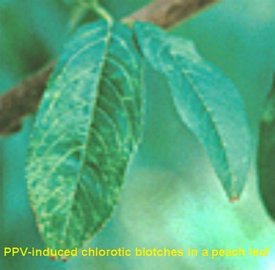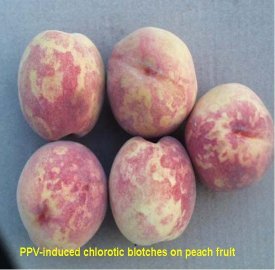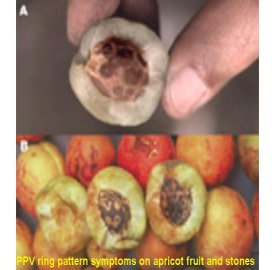Plum Pox
M. Babadoost
Plum pox, also known as sharka, is the most devastating disease of stone fruit including peaches, nectarines, plumes, apricots, almonds, and sweet and tart cherries. First describer on plums in Bulgaria in 1915, plum pox has spread to a large part of Europe, the Mediterranean, the Middle East, India, Chile, and Canada. In 1999, for the first time in the United States, plum pox was detected in peach orchards in Adams County in Pennsylvania.
Plum pox is economically important because it can reduce the yield and quality of infected trees. The infected fruit may be unmarketable. Severity of the disease varies with the variety, age of the plant, the strain of the virus, and the temperature.
Plum pox is caused by plum pox virus (PPV). PPV is a potyvirus (it resembles potato virus Y). Four PPV groups, including PPV-D, PPV-M, PPV-C, and PPV-EA, have been described to date. These strains can be identified using laboratory tests. The most common European strains are PPV-D and PPV-M. These two strains differ in symptom severity among host species and in patterns of spread by aphids. Both PPV-D and PPV-M infect peach, plum, and apricot. PPV-C has been reported on cherry trees from Moldova. This strain infects sweet and tart cherry naturally and has been reported to infect other Prunus hosts experimentally. PPV-EA has been reported on apricot in Egypt. The strain detected in Pennsylvania was PPV-D.
In peach, PPV-infected trees may exhibit color-breaking symptoms in blossoms; this appears as darker pink stripes on the flower petals and can be useful for early season detection. Diagnostic symptoms on leaves may consist of mild light green discoloration bordering the leaf veins (vein yellowing) or yellow to light green rings. These symptoms may be only barely visible to the eye. Peach and apricot fruit may develop lightly pigmented yellow rings or line patterns resulting from several rings running together on the surface of the fruit. Fruit may become deformed and develop necrotic or dead areas. Apricot fruit may show no external evidence of disease, but may have white ring or line patterns on the seed.
Plums generally are more severely affected and show more severe symptoms than other stone fruits. Therefore, they are a good indicator host to observe for symptoms of infection, allowing growers to monitor for PPV in orchards. For some plum cultivars, infected fruit drop prematurely from trees. Infected plum fruits are often severely deformed and develop darker rings or spots on the skin and a reddish discoloration of the flesh. Some infected plants may not exhibit symptoms at all. Serological tests, however, can detect PPV even before visual symptoms develop.
Aphids transmit PPV within an orchard and from trees to nearby orchards. Long distance spread of PPV usually occurs as a result of the movement of infected nursery stock or propagative materials. Studies have indicated that several aphid species, including the green peach aphid (Myzus persicae), transmit PPV. Aphids spread plum pox in a non-persistent manner. How PPV was introduced into the United States is not known.
Control of plum pox can be achieved by adopting preventive measures. If PPV becomes established, it is very difficult or impossible to eradicate the pathogen. Some of the effective methods to control PPV are: (i) use of certified nursery materials, (ii) use of resistant cultivars (when available), (iii) eradication of infected trees, and (iv) control of aphids.
Illinois has approximately 3,500 acres of commercial orchards, 11,000 scion (budwood) trees, 450,000 nursery stocks, and considerable amounts of garden trees of stone fruits. Production of stone fruits is concentrated in central and southern parts of Illinois. Stone fruit production is considered to be an important component of the agricultural economy in Illinois. Any plum pox infection in Illinois would be a serious threat to the stone fruit industry of the state.
During 2000-2001, under auspicious of the Animal and Plant Health Inspection Service of the
United States Department of Agriculture (APHIS-USDA), surveys were
conducted to determine if PPV was present in stone-fruit trees in
Illinois. In 2000, 4,593 samples (representing 36,744 trees), and in
2001, 3,852 samples (representing 30,816 trees), were collected from
commercial orchards and nurseries in Illinois and tested for PPV
enzyme-linked immunosorbent assay (ELISA) method. PPV was not detected
in any of the samples tested. Thus, Illinois was considered a PPV-free
state. To protect the industry and home yard production of stone fruits,
we need to keep Illinois as a PPV-free state. This could be achieved by
using certified nursery stock and preventing entry of PPV-infected
materials to Illinois.



